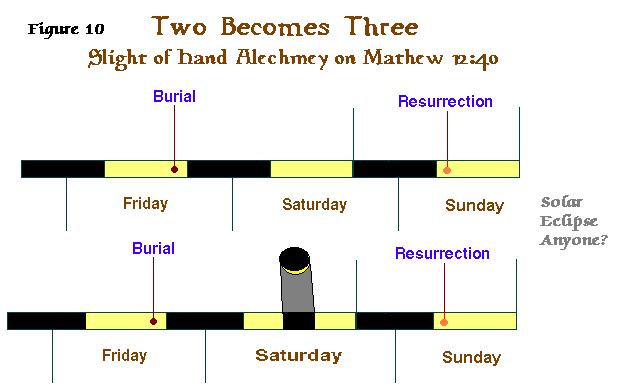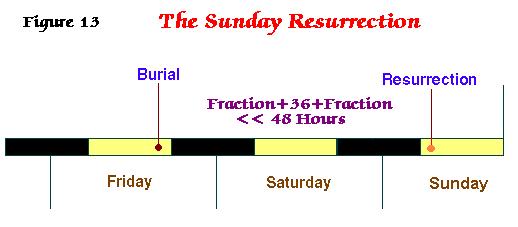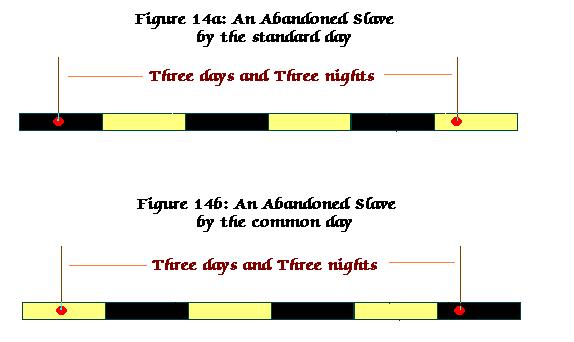|
|
|
|
§72
On the basis of Matthew 12:40, we have argued that it is necessary to have
"three nights" for the time Yayshua was in the grave. An examination
of the Sunday chronology shows it has only two nights in the interval from
Christ's death to his resurrection. In spite of this, Sunday resurrectionists
do have a standard pat answer to Matthew 12:40 to make it appear that their
chronology really does have "three nights." This response ranks as
one of their most ingenious and computational. It is also the most
often heard response given to those who point out that Matthew 12:40 does
not fit their Friday-Sunday chronology.
§73
The Sunday resurrectionist response to Matthew 12:40 begins with a quote
from the Jerusalem Talmud, "A day and a night are an onah, and the part
of an onah is as the whole of it" (Mishnah, "J. Shabbath," Chapter IX,
par. 3). As a source, this talmudic quote is important because it
reflects semitic usage and thinking concerning the enumeration of days
and nights. Also it could well find its origin, as a tradition, in
some first century oral saying.
§74
The above quote contains the Hebrew word "onah," and this means, "a period
of time." A day and a night is one example of an "onah" (i.e.
a period of time). No one will dispute this. The next phrase,
however, is true only in a certain sense, "part of an onah is as the whole
of it." This means that a portion of a period of time is counted
with a whole number, i.e the number 1. On the other hand, although
a portion of a period of time may be counted with the numeral 1, this does
not mean that a portion of a period of time is equal to a whole period
of time. That is, it does not mean that part of a day is equal to
a whole day, but only that part of a day is counted as 1 day.
§75
The foregoing distinction may seem trivial, but it is critical. If
we go so far to say something equals something else, then we may apply
all the rules of mathematics for equations. But if something is only
given an alternative label, i.e. the number 1 for part of a day, yet it
is not an equation (it is obvious that a part does not equal a whole),
then the rules of equations do not apply. In fact, the mathematical
axioms for equations are totally invalid if used on anything not already
an equation.§92 And, it is clear that, "part
of an onah is as the whole of it" is not an equation. The phrase
only sums up a linguistic or idiomatic convention used in the Hebrew language.
It is not an equation.
§76
Nevertheless, Sunday resurrectionists proceed as if "part of an onah is
as the whole of it" is an equation. Their mathematical reasoning
is summarized below. "D" equal's a day and "N" a night. "O"
means an "onah" or a period of time.
§77
Equation (1) is derived from "a day and a night are an onah," and "equation"
(2) from "part of an onah is as the whole of it." We have already
explained the invalidity of making the second half of the statement into
an equation. We proceed anyway, so as to demonstrate how sundayists
arive at three nights.
§78 Observe here that one of the days has transformed itself into a day plus a night (see Fig. 10). The alchemy is similar to the day Aaron threw gold into the fire and out walked the golden calf. Josh McDowell, uses the derived Eq (7) above when he states, "Any time before 6:00 p.m. Friday would be considered 'one day and one night'" in his book The Resurrection Factor (San Bernardino: Here's Life Pub., Inc.), 1981. That is, he is expanding the part of a day between the death of Christ and sunset on Friday, into a day plus a night. However, since Eq (2) is invalid, the operation of subsitution needed to arrive at Eq (7) is also invalid. The Talmud really only allows McDowell to count that part of a day as 1 day.




§83.1
Samuel 30:12 reads as follows: "For he had eaten no bread, nor drunk any
water, three days and three nights," and he said "today is the third day"
(1 Sam. 30:13).
§84
Our man falls sick at the first dot (see Fig. 14a),
and he does not eat his breakfast. He is unable to travel and is
abandoned. He goes without food or drink a total of three days and
three nights. On the third day since his abandonment he is found.
Clearly this proves the idiomatic inclusive reckoning. But
it fails to prove that three days and three nights can be less than 48
hours. In other words, it also fails to prove that three nights equals
two.

§85
Esther told the Jews to "neither eat nor drink for three days, night or
day," (Esther 4:16), and then "on the third day" we assume she took food
and went before the king (Esther 5:1). If we assume that she meant
"three days and three nights," then this case is precisely like the former
case. It fails to prove that the period is less than the theoretical
minimum of 48 hours for the idiomatic reckoning. Therefore, it fails
to prove that three equals two.
§86
Previous chronologers have failed to refute the Sunday position adequately
because they have assumed Christ was in the grave exactly 72 hours, giving
the opposition something to criticise. Indeed, that would be four
days and three nights. If they had considered the evidence produced
by scholars for inclusive reckoning they would have discovered that 72
hours was unnecessary, but that at least 48 hours was necessary.
Since the Sunday view lacks 48 hours, it follows that even granting the
idiomatic interpretation of Matthew 12:40, the Sunday position fails utterly.
The only solution for them is to accept Matthew 12:40 or chop it out of
their Bibles.
§87
To review, Christ was in the grave three days and three nights; he rose
after three days reckoned according to the standard day; he rose on the
third day according to the common day; he rose on the first of the Sabbaths;
he rose on the later of the Sabbaths in Passover week. He died before
the Passover Sabbath. He died on the preparation day for the Passover
Sabbath, and he rose on the weekly Sabbath.
.
§88
One writer claims that "three days and three nights" is a hendiadys for
"three days."§91 He cites "heavens and earth"
(Gen. 1:1) as an example of hendiadys, and "flesh and blood," (Matthew
18:17). He claims since "heavens and earth" means "everything" and
"flesh and blood" means "man" so "three days and three nights" must mean
"three days," and not "three nights."
§89
However, this is absurd logic. Does "heaveans and earth" mean heaven,
and not earth? Does "flesh and blood" mean flesh, and not blood?
The fallacy used by this author is in reasoning from the specific to the
more general, and then denying one or more of the specifics upon which
the generality is based. It is far better to treat "three nights"
as "earth" and "blood." They are all real entities.
§90
I can't help but note the spiritual bankruptcy of the Church's position.
In their error they have forgotten the truth of simple mathematics and
numbers. In fact, if God was not concerned about accuracy in numbers,
he would not have put so many of them in the Bible.
.
§91
Pg. 235, Today's Handbook for Solving Bible Difficulties, David
E. Obrien.
§92
Occasionally, mathematicians have tried to kid the public by proving
such things as 2 = 3. Always some fallacy is involved in the "proof."
legacy name: www.parsimony.org